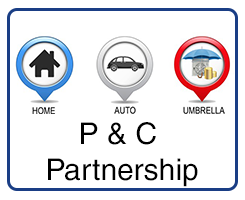Partnership Programs
Partnering with other like-minded organizations who serve similar clients is a fantastic way to grow your business. The key is to set up a program that creates success and accountability. This page will help you understand how to begin that process.
We have also developed specific programs you can use to get started. Those are listed at the bottom of the page.
Step One – Finding potential partners
Before starting your efforts to find potential partners, let’s get organized. It is important to document your efforts. This will help you avoid missing any opportunities or accidentally calling the same agent twice. The first step is to build a simple spreadsheet that captures the following information:
If you have a more advanced Customer Relationship Management program or system, build a way to document your partnership efforts.
Locating prospects may seem difficult, but it doesn’t have to be. There are several strategies that will provide an abundance of opportunities for you.
Networking
Every city has business networking groups that meet regularly. These are terrific places to meet potential partners.
In a networking environment your focus should be to simply make connection, not close the deal. Get to know potential partners. Invite them to get coffee at a later date. See if you can make a referral to them. As your relationship grows, the opportunity to introduce the partnership will present itself naturally.
Many sales pros are eager to ‘get to business’, and tend to discount the benefit of building strategic relationships. Keep in mind that if you push too hard, too early on a potential partner, you not only jeopardize that relationship, but you also run the risk of being labeled ‘pushy’ by those your prospect knows. In a networking environment – as opposed to a cold calling environment – slow and steady is the best strategy.
Online via Social Media such as LinkedIn
Having an active social media presence will generate a significant amount of connections for you. Unfortunately, many people are not comfortable with such an active social profile. Fear not, you can still use tools like LinkedIn to find potential partnership prospects.
LinkedIn is a great tool for finding connections. The search tools available are powerful. Let’s look at three quick strategies for making LinkedIn connections:
InMail – This is LinkedIn’s version of guaranteed delivery email. You purchase InMails from LinkedIn. They guarantee that the recipient will respond or they’ll credit your account. With a solid initial message, (see samples) you can reach out via InMail to any potential partners in your area.
Once they respond, invite them to connect with you. From there you can have unlimited interactions via LinkedIn’s normal email system.
Group Memberships – LinkedIn has many groups for people with special interests. A quick keyword search will usually find multiple groups with target prospects.
As you find groups with good targets, join them. Some groups are very easy to join, others are more exclusive, but be persistent and get engaged with more than one group (you can join up to 50 at a time).
Once you have joined a group, engage in conversation with your potential prospects. If you see a question or thread where they have participated, join in with a comment or question. Post your own comments, suggestions, questions, or information to the group.
This activity will generate feedback to you from others. As you receive this feedback, determine if they could become a potential partner. If they will, ask to connect and begin building a relationship
Selective Messaging – LinkedIn offers the ability to communicate directly with group members even if you are not a connection. As you grow your group memberships, you can find potential partners within the groups and directly message them.
As with InMail, this requires some careful scripting. Once a prospect replies to you directly, you can ask to connect and continue the conversation via the normal LinkedIn email system.
Each of these tactics is a powerful way to not only grow your potential partners, but also to increase your connections strategically on LinkedIn. The more solid connections you have the more eager others are to engage with you. Keep in mind – in person or on the Internet – there is power in your network.
Cold Calling
If you prefer the direct method of selling, there is always the cold call. Use the scripts we’ve developed to create your own pitch. Once you do, you can use tools like Google to easily find target prospects. Search your geographical area for your target and a map will show you all the results. Click on the map indicators and usually a phone number and address will appear.
Step Two – Engaging Your Prospect
Regardless of how you connect with your prospect, the next steps are similar:
Distribute the video. We’ve developed a video to engage P&C agents. These videos require a bit of set up – ideally in person – that includes a commitment to watch the video and respond one way or the other. The sample script below demonstrates how this might be achieved for a P&C partner:
Hello __________, my name is ______________.
I’m an independent life insurance agent here in _________. I don’t want to take up your time today – but I partner with P&C agents like you to leverage a life insurance strategy that can be very lucrative for you without competing with the life insurance sales you’re already doing.
I know you are busy, so I’d like to send you a short video that talks about the hidden commissions sitting in your client files. Would you be willing to watch it?
Great – I’ll send you an email with the video link right away – all I need is your email address. Would you be able to have a 5-minute follow-up conversation with me on ______day? What time of day works best for you? Is a better number or cell phone I should use to I’m sure to get through to you directly?
Super. I’m going to send the video out right now. It will come from me – again my name is _____________ so watch for the email, and we’ll have a quick follow-up chat about it on ____day.
If pressed for what the video is about:
Well – I imagine you sell life insurance don’t you? Yes. Do you have all the life sales you need? Never have all we need. What the video does is introduce you to a marketing strategy that will help you ramp up your life sales significantly at no cost, and with very little effort. Would that be worth three minutes of your time?
Try not to let the conversation get too far into the details unless the agent wants to meet and talk about it in person.
Follow-Up. When you send the video to your prospect, get a verbal commitment to follow up. When you call to follow up, if they didn’t watch the video, you’ll want to ‘call him out’ and get agreement to either watch it – or meet with you for about 20 minutes to outline the commission-mining strategy.
Step Three – Create a Partnership Agreement.
Once you’ve formed the basis for an agreement, define the efforts and expectations you have for the partnership. Each specific program has its own set of metrics and expectations, but it is important to agree to and identify – in writing – the following:
- Partner’s role with specific metrics and expectations that can be measured
- Your role with specific metrics and expectations that can be measured
- System reporting metrics – lead tracking, appointment scheduling, closing rate, etc.
- Payment details – how payment will be made, when it will happen, how much, etc.
Step Four – Review & Renewal.
Over time, the partnership program will develop. To be sure that this development is positive for all parties, it is important to build in an element of review. Based on the dynamics of your partnership, this can be informal, or more defined such as a renewal process.
The review/renewal process should have defined milestones. Initially you will be working together frequently, but over time that interaction may diminish. Having an agreed review structure will keep all parties on track.
90-day review – The first 90 days will be critical for any partnership. In most cases both parties will have some issues to review. Common 90-day issues include:
- Is the program working as anticipated? If not, what are the issues? Resolution plan
- What areas can be improved? On our part? On their part?
- Are the results as expected? If not:
- Are enough new prospects being engaged? Are they being engaged effectively? How do we know?
- Is your follow up effective? What is the appointment rate? What is the close rate?
- Is the partner compensation adequate? If not, what needs to change? Is this reasonable?
6-month review – Assuming a 90-day review, the 6-month review can be the standard ‘check up’ on the process. Common 6-month issues include:
- Can we circle back to previously solicited prospects? If so, how?
- Can we expand the program?
- How can we improve the system?
Annual review – The annual review will be a combination of all these issues after the first year. This is just a time to renew the basis for the partnership, address concerns, talk about new opportunities, and catch up on each other and the relationship.




